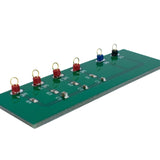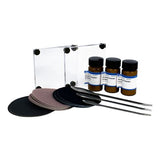PEEK vs PTFE

The choice of whether to use PEEK (polyether ether ketone) or PTFE (polytetrafluoroethylene, Teflon) comes down to the conditions of your planned experiments. The key polymer properties to consider are:
If your experiment requires a specific chemical environment that isn’t compatible with one of the polymers then this is your priority. The same applies to mechanical toughness, thermal stability and electrical insulation. The conditions of your experiment dictate which polymer you should pick.
PEEK vs PTFE Chemical Resistance
PEEK exhibits good solvent compatibility with a lot of electrolytes typically used in electrochemistry. However, there are a few that will readily dissolve PEEK and some that can cause some deformation (see the table below ).
PTFE on the other hand is mostly inert. It will react with alkali metals and can be dissolved in perfluorokerosenes and perfluorinated oils. So, if you want to use any of the solvents listed below as your electrolyte, you may want to purchase a working electrode with a PTFE body.
| Incompatible with PEEK | May discolour or deform PEEK |
|---|---|
|
|
PEEK vs PTFE Mechanical Stability
|
Property |
PEEK |
PTFE |
Best Performer |
|
Tensile Strength / MPa |
90-100 |
25-35 |
PEEK |
|
Elongation / % |
30-40 |
350-400 |
PEEK |
|
Compressive Strength / MPa |
140 |
30-40 |
PEEK |
|
Shore Hardness / D |
85 |
55 |
PEEK |
|
Flexural Modulus / MPa |
3900 |
495 |
PEEK |
|
Coefficient of Friction |
0.35-0.45 |
0.03-0.05 |
PTFE |
According to the mechanical property data there are key differences between PEEK and PTFE. PEEK is extremely strong and resistant to deformation making it suitable for experiments where the electrode might be put under physical stress or repeated mechanical cycling. A downside to this strength is that the standard alumina electrode polishing powders won’t wear down the PEEK. So, it’s possible that, eventually, the electrode material might wear enough that it is no longer flush with the PEEK body. A machine polisher can prevent this.
PTFE has a low coefficient of friction which minimizes wear and tear in experiments where the electrode might be moved or adjusted frequently. This contributes to the longevity of the electrochemical cell set up, especially in systems that involve frequent assembly and disassembly.
PEEK vs PTFE Thermal Stability
|
Property |
PEEK |
PTFE |
|
Coefficient of linear thermal expansion / K |
5 x 10-5 |
14 x 10-5 |
PEEK has a lower coefficient of thermal expansion, and the coefficient increases more linearly with temperature (at least up to 80-100 °C). This thermal stability is crucial when using PEEK electrodes in high-temperature electrochemical processes.
Whereas PTFE electrodes can be unsuitable for applications that require high temperature thermal cycling. Although PTFE has a relatively high melting point (327 °C) and low linear thermal expansion under 25 °C, above 25 the coefficient of thermal expansion increases nonlinearly. At experiments at high temperatures there is chance that the PTFE body will begin to protrude beyond the electrode material, or that electrolyte can seep between the electrode material and the PTFE body.
PEEK vs PTFE Electrical Insulation
|
Property |
PEEK |
PTFE |
|
Dielectric Strength kV/mm |
50 |
50-150 |
|
Volume Resistivity Ohm/m |
1013 -1014 |
1016 -1018 |
While both polymers are highly insulating, PTFE is more resistant to voltage and acts as a better insulator than PEEK. These properties helps prevent unwanted electrical currents from passing through the body of the electrode, ensuring that all current is focused on the electrode surface where the electrochemical reaction takes place.
Electrodes

Learn More
 Troubleshooting Cyclic Voltammetry and Voltammograms
Troubleshooting Cyclic Voltammetry and Voltammograms
Cyclic voltammetry is a powerful and versatile electrochemical technique. With modern potentiostats and software packages, the method is relatively straight-forward to perform. Despite this apparent simplicity, there are still a number of things that can go wrong, particularly when setting up the electrochemical cell.
Read more... How to Use the Electrode Polishing Kit
How to Use the Electrode Polishing Kit
A step-by-step guide for how to use the electrode polishing kit to keep your electrodes up to the highest possible standard.
Read more...References
- Chemical resistance of PEEK and other polymers, VICI AG International (2017)
- When PTFE is better than PEEK?, Wojcik, P.J. (2021)
- PTFE vs PEEK - A Comparison of Properties, Poly Fluoro Ltd, The Definitive Blog on Polymers (2013)
- Electrical Properties of Plastic Materials, Professional Plastics